
Ferromagnetic materials are materials that have magnetic properties similar
to those of iron. They can become permanently magnetized. Examples of
ferromagnetic materials are nickel, cobalt, and alnico, an
aluminum-nickel-cobalt alloy.
Magnetic fields are produced by currents. Permanent magnets are the result of
"magnetization currents" flowing inside the material. The magnetization currents
in materials are a consequence of the electron's orbital motion and spin. Electrons have an
intrinsic property, called spin. Because they have spin, they have a magnetic
moment, similar to a small current loop. Electrons by themselves act like tiny
magnets. If you pick an axis, an electron's magnetic moment can either be
parallel or anti-parallel to this axis. In an atom the electrons are arranged in orbitals. An orbiting electron can have an additional magnetic moment similar to
the magnetic moment of a tiny current loop. If all the magnetic moments of the
electrons in an atom do not completely cancel out, then the atom will act like a
tiny magnet.

When any material is placed into a magnetic field its atoms acquire an induced magnetic moment pointing in a direction opposite to that of the external field. The material becomes magnetic. This is called diamagnetism. The diamagnetic field produced by the material opposes the external field, but, except in superconductors, this diamagnetic field is very weak. If the atoms of a material have no magnetic moment of their own then diamagnetism is the only magnetic property of the material and the material is called diamagnetic. Copper is such a material.
External link: Graphite is a diamagnetic material. It is repelled by both poles of a magnet. (Youtube)
In paramagnetic materials all the magnetic moments of the electrons in an atom do not completely cancel out, and each atom has a magnetic moment. However, in paramagnetic materials such as aluminum, neighboring atoms do not align themselves with each other in the absence of an external magnetic field. The magnetic fields produced by the individual atoms therefore cancel each other. An external magnetic field tends to align the magnetic moments in the direction of the applied field, but thermal motion tends to randomize the directions. The paramagnetic field produced by the aligned magnetic moments reinforces the external field, but at room temperatures it is on the average only approximately 10 times stronger than the diamagnetic field and therefore still very weak.
External link:
Liquid oxygen is a paramagnetic material.
It is attracted to the poles of a magnet. (Youtube)
In ferromagnetic materials, the spins of neighboring atoms do align even in the absence of an external field (through a quantum effect known as exchange coupling), resulting in small (a tenth of a millimeter, or less) neighborhoods called domains where all the moments are aligned. In a non-magnetized piece of ferromagnetic material the domains are randomly oriented. When a piece of ferromagnetic material is placed into an external magnetic field, two things happen.
In this way the piece of material becomes magnetized.
Iron comes in two forms, hard and soft. Hard and soft are term describing the magnetic properties of the material. In hard iron the domains do not shift back into their random positions when the external field is removed. In soft iron, the domains do shift back into their random positions when the external field is removed. To make permanent magnets a piece of hard iron is placed into a magnetic field. The domains align with the field, and they retain most of that alignment when the field is removed. Soft iron is used as a core in electromagnets. A wire is wound around an iron core. A current flowing through the wire coil produces its own magnetic field and magnetizes the iron. The magnetic field produced by the iron is much stronger than the field produced by the current in the coil. Typically an iron core magnifies the field by a factor of 100 to 1000. When the current in the coil is reduced to zero, the soft iron core loses its magnetization.
Magnetic effects are temperature sensitive. At higher temperatures the atoms in the material have a higher average kinetic energy, and it is easier for interactions to misalign the spins. Above a critical temperature known as the Curie temperature, ferromagnets lose their ferromagnetic properties.
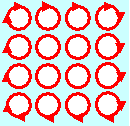 Macroscopically, magnets act like current loops. The internal
"magnetization currents" produce a net "magnetization current" flowing along the surface of the
material. (In the interior of the material currents flowing in opposite
directions produce zero net current.)
Macroscopically, magnets act like current loops. The internal
"magnetization currents" produce a net "magnetization current" flowing along the surface of the
material. (In the interior of the material currents flowing in opposite
directions produce zero net current.)
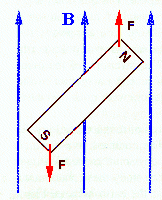 In an external magnetic field
produced by another magnet or by a current flowing in a wire, magnets
are therefore acted on by forces and torques. In a uniform
external field, a current loop, and therefore a magnet, experiences no
net force, but a net torque. The torque tries to align the
magnetic moment of the magnet with the external field.
In an external magnetic field
produced by another magnet or by a current flowing in a wire, magnets
are therefore acted on by forces and torques. In a uniform
external field, a current loop, and therefore a magnet, experiences no
net force, but a net torque. The torque tries to align the
magnetic moment of the magnet with the external field.
The magnetic moment of a magnet points from its south pole to its north pole.
In a non-uniform magnetic field a current loop, and therefore a magnet,
experiences a net force.
The force tries to pull an
aligned dipole into regions where the magnitude of the magnetic field is
larger and push an anti-aligned dipole into regions where magnitude the
magnetic field is smaller.
If the magnetic field is pointing into the z-direction,
the force on a magnetic dipole in that field is given by
Fz = μzΔBz/Δz.
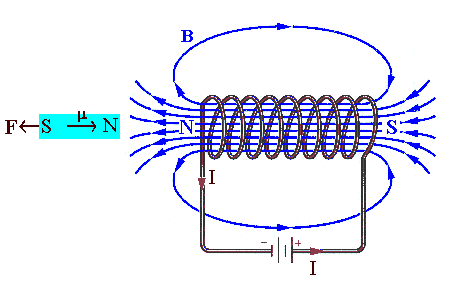
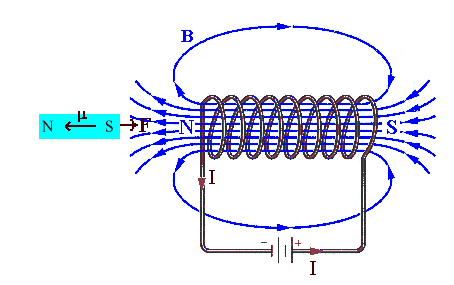
Remember: When two magnets are brought together, unlike poles attract and like poles repel.
Eternal link: Force between magnets (Youtube)
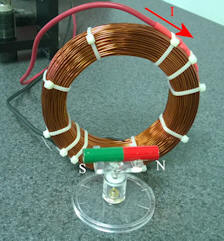 A demo: A permanent magnet is placid in front of a current loop. as
shown in the picture on the right. The magnet is on a swivel stand and can
rotate.
A demo: A permanent magnet is placid in front of a current loop. as
shown in the picture on the right. The magnet is on a swivel stand and can
rotate.
Make a prediction! When we connect the power supply, the magnet will
Discuss this with your fellow students in the discussion forum!
What is the force and torques on magnets in magnetic fields?
 The earth magnetic field
The earth magnetic fieldNear the surface of the earth magnets orient themselves so that
their north poles point north. In the magnetic field of the earth they
experience a torque that tries to align them with the earth magnetic field. The
pattern of the field lines resembles that of a bar magnet. Near Knoxville,
TN, the strength of the Earth magnetic field is ~ 53 microT.
Inside a bar magnet and near the center of the earth the
magnetic field points from the magnetic south pole towards the magnetic north
pole. Outside the bar magnet and near the surface of the earth the magnetic
field lines complete the loop from the magnetic north pole to the magnetic south
pole. Since the direction of the magnetic field near the earth surface is
towards the north, the must be a magnetic south pole located near the geographic
north pole, as shown in the diagram to the right.